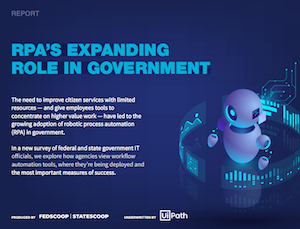- Sponsored
- Modernization
Government agencies harness RPA ‘bots’ to build capacity, improve services

Federal and state government workers are beginning to benefit from a growing army of digital robots designed to streamline agency workloads and quicken the delivery of public services.
The robots — or more accurately, robotic process automation (RPA) applications — are gaining widening adoption across government agencies, according to a new survey of federal and state government business, program and IT officials.

Read the full report.
More than 6 in 10 federal respondents — and 4 in 10 state respondents — in the survey said their agency now uses RPA technology to facilitate work. And it appears the momentum for using RPA technology is building quickly in government. Of those at agencies putting RPA to work, two-thirds have begun piloting, or deploying RPA within the last 12 months.
The findings are based on a new survey, completed by 167 prequalified executives at federal and state government agencies, responsible for their agencies’ business, program or enterprise operations, including IT, customer service and acquisition officials. The survey was conducted by FedScoop and StateScoop, with underwriting support from UiPath, a leading provider of RPA software solutions
Among other key findings:
- 6 in 10 federal respondents — and half of state respondents — view RPA as a building block to harnessing artificial intelligence and machine learning, by accelerating data gathering and improving data quality.
- RPA is being put to work in widening range of applications, including efforts to streamline data collection and processing, document management, identity verification and to respond automatically to citizens’ information requests.
- While the number of RPA applications varies according to agency size and experience, among respondents familiar with the numbers, half said their agency had developed or deployed more than 50 RPA robots as of the end of last year.
- 1 in 3 respondents said that RPA technology has saved between 5,000 and 50,000 hours of routine work, allowing employees to re-channel their time and efforts to more value-added areas of public service.
Because RPA requires little or no coding, and can be deployed with minimal training, it is relatively easy for employees to apply it successfully to automate all kinds of business processes and online services, according to James Walker, chief technology officer for public sector at UiPath.
The study suggests that once RPA’s benefits are demonstrated in one area, it opens up consideration for uses elsewhere.
But RPA also provides a way to help budget-constrained agencies boost capacity, observed Walker. “Automation can begin to liberate agency staff from repetitive, lower-valued — but necessary — work and enable them to focus on higher-valued tasks needed to achieve their mission.”
Read the full report, “RPA’s expanding role in government,” for the detailed findings, or contact automation@uipath.com to learn more about automating workflows.
This article was produced by FedScoop and StateScoop and underwritten by UiPath.






